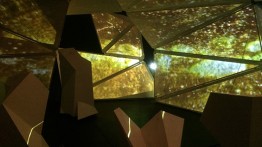A talk with Artists Emmy Mikelson and Charlotte Becket
POSTED ON: December 8, 2017

For her "day job," Emmy Mikelson is Coordinator for Student Exhibitions and Special Projects in the School of Art. This Friday, December 8, she and artist Charlotte Becket will exhibit their own work at CultureHub in the East Village. Their piece, a multimedia work entitled "Displaced Plan," creates an immersive environment of sound and color that blurs the line between physical and digital space.
We talked to the artists about Displaced Plan, their first collaboration. The interview follows below.

1.How did you come to create Displaced Plan?
We’ve had an ongoing discussion about our artwork for several years. Many of the ideas overlap and build on each other, consciously or not. Often people come to our studios and point out the ways that our work is in dialogue that we may not have been aware of. In the past, we’ve both enjoyed collaborating with other artists. After imagining how to combine our work, we submitted proposals and were awarded two experimental media residencies at Signal Culture in Owego, NY and CultureHub at La MaMa Gallery in NYC. Through a process of experimentation and investigation of technologies new to both of our practices, Displaced Plan evolved.
2. Please describe how you made the piece.
The project is a large-scale interactive installation using kinetic sculptural forms and projected video that layers digital and physical space. The physical space consists of a flexing projection screen and interactive sculptural interfaces. These forms (the screen and the sculptures) take their formal compositional ques from low-poly digital 3D rendering. In this way, there is explicitly a shared language between digital and physical forms. The physical forms in the space were constructed using wood, foam core, and Tyvek. Viewers are invited to move the sculptural forms by turning them. In doing so, participants are able to “draw” shapes onto the installation to reveal and conceal the video. This interactivity is achieved through Arduino microcontrollers and the program Processing. This software allows you to design and code a custom drawing application, among many other possibilities.
3. Emmy, you edited a book on nonanthropocentrism. Does that philosophy inform “Displaced Plan”?
Non-anthropocentrism is an influential topic for my work. This idea seeks to question and antagonize the centrality of the human subject. The goal is to give equal consideration to a diverse set of subjects, such as animals, ecological conditions, objects, and so on. I have used this strategy of avoiding the human subject to develop a body of art work that explores microbial landscapes, architectonic spaces, and dense forest ecosystems. These same ideas help structure the video I shot and edited for the Displaced Plan project. The footage for the video is from tanks I keep in my studio where a grow bacteria in an aquatic environment. I mix pigments and mica powders into the tanks to create the imagery. The imagery is a 30-minute video on a loop using 3 projections to cover the surface of the sculpture.
4. Displaced Plan is based on natural phenomena, such as Fingal’s Cave in Scotland and Death Valley. Did those places have a similar emotional resonance to you that you’re trying to impart to viewers or do moods shift within the work?
Both our individual art practices take inspiration from naturally occurring, though not always clearly understood, geological phenomena. Beautiful and terrifying giant “blue holes;” Fingal’s Cave in Scotland; Planctae, the wandering rocks of Death Valley that are named after the monstrous rocks of Homer’s Odyssey; and La Mancha Negra, the mysterious oil-like black stain found in Venezuela. They are reminders of the vastness of geologic time compared to a human timescale and provoke a sense of curiosity.
5. Is there an audio component?
The audio is a key component to the project. All of the sound is created in the studio using a recorder and analogue synthesizer. It loops with the video and is synced to the imagery creating a soundscape for the installation.
6. Can you speak to the tension and/or affinities between using digital technologies to make art about natural landscapes? I’m imagining that’s something you both think about a lot.
In this work we aimed to create mirage-like hybrids as a metaphor for understanding and making sense of coexistent realities (such as digital and physical space). The composite view created through layering physical and digital space embraces the condition of both near and far, the tangible and the mirage, the landscape and the hallucination.




